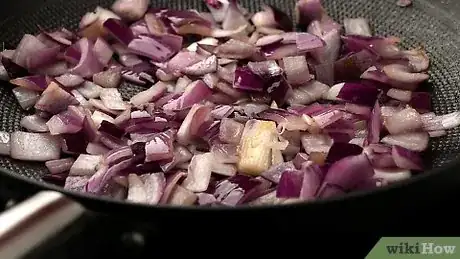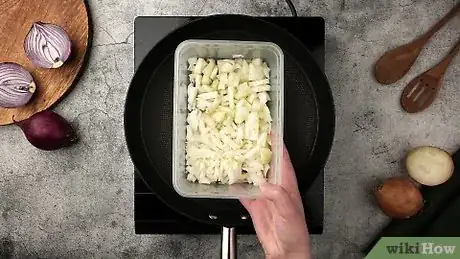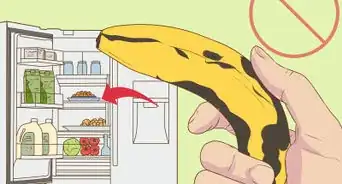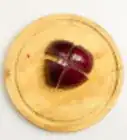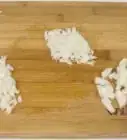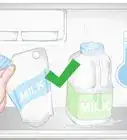This article was co-authored by Olivia Choong. Olivia Choong is a Plant and Gardening Specialist and the Owner of The Tender Gardener. With more than six years of experience, she specializes in gardening, permaculture, and self-sufficient and low-impact living practices. Her work has been featured in media outlets such as The Straits Times and Channel NewsAsia (CNA). Olivia holds a Bachelor of Mass Communications in PR and Journalism from Murdoch University.
There are 11 references cited in this article, which can be found at the bottom of the page.
This article has been viewed 157,780 times.
Sometimes you only need to cook with a portion of an onion, and you may not be sure what to do with the rest. Fortunately, you can store cut onions, but they need to be stored differently than whole ones. Without their exterior layers intact, cut onions are susceptible to bacteria and mold. To reuse a cut onion, you'll need to prepare it correctly, choose an appropriate container, and store it at the right temperature. With a little preparation, you can enjoy the rest of your onion when the time is right.
Steps
Refrigerating a Cut Onion
-
1Keep your onion clean when preparing it for storage. Minimize exposure to harmful bacterial by preventing cross-contamination with uncooked meat and dairy products. Use separate cutting boards for meat and produce. Always wash your hands after handling uncooked meat and ensure that your knife is clean.
- If you have space, consider setting up dedicated areas for produce and meat preparation, so you don’t spread germs while cooking.
- Avoiding cross-contamination is especially important when preparing food for storage because storing food allows bacteria time to grow.
-
2Wrap large pieces of onion with plastic wrap. If you have half of an onion remaining or a few large wedges, then wrap them tightly in plastic wrap. Plastic wrap will insulate the onion from the outside air while helping it retain moisture.[1]Advertisement
-
3Place smaller onion pieces in an airtight bag. If you have smaller pieces of onion left over, use a resealable bag to store them. Never use cloth storage bags, as these are intended for whole produce and will not protect a cut onion from exposure to air.[2]
-
4Consider reusable containers if you have them. You can find airtight plastic containers for food storage at any big box store. These containers work great for refrigerating cut onions.
- There are also new, silicone products designed to stretch over and cover the exposed side of cut produce. Exercise caution when using these with onions. These products will not fully encase an onion, which can cause your refrigerator to smell.
-
5Store onions in your refrigerator at or below 40 °F (4 °C). Cut onions should always be stored in your refrigerator—not at room temperature. Keeping them at a low temperature inhibits the growth of bacteria and allows you to safely reuse them later.[3]
- Ignore any storage recommendations that suggest that cut onions can be stored at room temperature. Some common tips include storing onions in a bowl of water on a countertop. This approach only promotes bacteria growth.[4]
-
6Use or discard cut onions after 7-10 days. Try to reuse refrigerated onions as soon as possible. However, never use them if stored for over 10 days.[5]
- Store all cut onions for the same period of time regardless of variety. Even though you may find different storage recommendations for different onion varieties—such as yellow, white, red, pearl, or Vidalia—these recommendations are relevant only for whole onions, not for cut ones.
-
7Check if onions are fresh enough to use after storing. Throw away onions that appear cloudy, mushy, slimy, or moldy. Smell the onions to make sure there is no unusual odor, and if they give off an strong or unusual odor, dispose of them.[6]
-
8Plan to cook previously stored onions. Never serve previously stored onions raw. You’ll need to cook them first because the heat will kill off any bacteria that may have grown during storage.[7]
Freezing a Cut Onion for Extended Storage
-
1Chop the onion into small pieces. Large pieces of onion—like an onion half or wedges—do not freeze well. To freeze effectively, you’ll need to chop your remaining onion into small pieces, preferably1⁄4 inch (6.4 mm) cubes.
- Smaller onions freeze more evenly whereas larger sections often become freezer burned.
-
2Put the chopped onion into a freezer-safe container. You can use freezer-safe resealable bags. Alternatively, use a freezer-safe container made of either glass or plastic. Regardless of the type of container you select, make sure that the onion is spread out as thinly as possible. The thinner you spread the onion, the more evenly it will defrost when you’re ready to use it.[8]
- You don't have to blanch your onions beforehand if they're chopped.[9]
-
3Write the date you cut the onion on the container. Either write the date legibly on the container itself, or write it on a label or piece of paper. Stick the date to the container.[10]
- It’s easy to forget when you put something in the freezer. Having the date written on your onion container will ensure that you don’t lose track of when you stored it.
-
4Store your onion in the freezer for up to 8 months. Even though your onion is frozen, it won’t last forever. Check the date before using it to make sure it has not been stored for more than 8 months.[11]
-
5Use previously frozen onion in dishes with soft textures. Frozen onion becomes soft and sometimes quite mushy when cooked. Use previously frozen onion for stews, soups, casseroles and other dishes where the onion’s soft texture will be less noticeable.
-
6Add frozen onion directly to your pot or pan when cooking. Don't worry about trying to defrost your frozen onion before cooking. In fact, defrosting your onion before cooking will only lead to a mushier texture. If you only need to use a small portion of your frozen onion, and the pieces are frozen together, run the container under warm water until you can separate out the amount that you need.[12]
Community Q&A
-
QuestionHow do I store Vidalia onions uncut, with the skin on?
 Community AnswerI would just put them in a dry, dark place. Keep them in the packaging they came in, or store them in a plastic container.
Community AnswerI would just put them in a dry, dark place. Keep them in the packaging they came in, or store them in a plastic container. -
QuestionHow can I store several kilos of cut onion?
 Community AnswerIf you have the room in your freezer, then that´s an effective method. If you can, freeze the onion spread out on a sheet and then place it in containers, that way you can pick out the exact amount you need later.
Community AnswerIf you have the room in your freezer, then that´s an effective method. If you can, freeze the onion spread out on a sheet and then place it in containers, that way you can pick out the exact amount you need later. -
QuestionCan I chop onions in advance?
 Community AnswerYes! I always chop one or two onions into small pieces and store them in a Ziploc bag; they'll keep very well for a week or so. You can store them in plastic containers if you prefer, but it can be a challenge to get the onion smell out of the container.
Community AnswerYes! I always chop one or two onions into small pieces and store them in a Ziploc bag; they'll keep very well for a week or so. You can store them in plastic containers if you prefer, but it can be a challenge to get the onion smell out of the container.
Warnings
- Don’t confuse instructions for cut and uncut onions.⧼thumbs_response⧽
- Follow instructions on the package if you purchased precut onion. These may have been prepared a long time ago and may not last as long as a recently cut onion.⧼thumbs_response⧽
References
- ↑ https://www.cooksillustrated.com/how_tos/5600-storing-sliced-onions
- ↑ http://www.melaniecooks.com/how-to-store-half-of-an-onion/1515/
- ↑ https://www.onions-usa.org/all-about-onions/how-to-select-cut-prepare-store-onions
- ↑ https://www.cooksillustrated.com/how_tos/9310-storing-half-an-onion
- ↑ http://www.stilltasty.com/fooditems/index/17826
- ↑ https://www.bestfoodfacts.org/leftover-onions/
- ↑ https://www.onions-usa.org/all-about-onions/how-to-select-cut-prepare-store-onions
- ↑ https://brownthumbmama.com/how-to-freeze-onions/
- ↑ https://food.unl.edu/article/freezing-onions
About This Article
To store a cut onion, start by wrapping large pieces of the onion in plastic wrap. Put smaller pieces in a resealable bag. Put the onion in your fridge and use it within 7-10 days. If you want to store a cut onion for longer, start by chopping it into small pieces and putting it in a freezer bag. You can store the onion in a freezer for 6-8 months.


